Shelf life of fried meat. Useful tips for housewives. How to speed up the ripening of fruits in the refrigerator
Food storage standards are written in various manuals. For businesses Catering they are strictly regulated by SanPiN, but at home everything is a little different, besides, not every house has a large refrigerator in which you can place all the products on different shelves.
Tidying up the fridge
Commodity neighborhood is a term that defines not only the possibility of storing food on one shelf in a supermarket, but also in home refrigerator. Failure to follow the simplest rules can lead to contamination of products with diseases and the transfer of bacteria, which in turn leads to food poisoning. FROM financial side- the right neighborhood of products keeps them fresher longer, which means you will throw away spoiled goods less.
Generally, seafood is very safe to eat, but raw or undercooked seafood can be unsafe due to viruses, bacteria, or parasites. Here are a few steps you can take to keep your seafood safe.
Tips for Choosing Fresh Clams
Buy fresh seafood only from reputable dealers who keep their products refrigerated or properly frozen. Be aware of possible cross-contamination of cooked and raw seafood if they are displayed on the same occasion. Make sure the raw fish is on a level below or well separated from the cooked fish so that the raw fish juices don't drip onto the cooked items. Do not buy frozen seafood if packages are open, torn, or shredded around the edges. Make sure frozen clams are packed in tight-fitting, moisture-proof containers. Buy fresh or frozen seafood at the end of your shopping trip so it doesn't get warm in your cart. Go straight home and freeze or freeze your seafood immediately. If your trip is longer than 30 minutes, place your seafood in an ice cooler. Steaks and fillets should be moist without discoloration. The shells of live clams, mussels, and oysters may appear naturally, but close tightly when tapped, indicating they are alive. Avoid overflowing in the refrigerator; allow air to circulate freely around the package. If you do not smoke for 1-2 days, wrap the seafood tightly with moisture-proof freezer paper or foil to protect it from air leaks and store it in freezer. Live clams should be chilled in containers covered with a clean, damp, non-sealed cloth. Discard shellfish such as lobsters, crabs, oysters, clams and mussels if they die during storage or if their shells crack or break. Live clams close when the shell is tapped. Store canned seafood in a cool, dry place for up to one year. Pasteurized foods such as crab meat can be stored for up to 6 months in the refrigerator. Once opened, use 3 to 5 days. Wash your hands thoroughly with hot soapy water before and after processing any raw seafood. You can also thaw cold water in an airtight plastic bag, changing the water every 30 minutes. Marinate seafood in the refrigerator, not on the counter. Discard marinade when mixed with raw juices. If you want to use the marinade as a dip or sauce, bring to a boil before serving or reserving a portion before adding the raw seafood. Keep raw seafood separate from ready-to-eat foods such as salad ingredients. Never use the same utensils or plates for raw and cooked food. Clean and disinfect surfaces, utensils and kitchen equipment after any contact with raw seafood.
- Never buy dented seafood cans.
- Look for hard, shiny flesh that bounces back when touched.
- If the head is on fire, the eyes of the fish should be transparent and bulge slightly.
- The gills should be bright pink or red without mucus.
- The fish should smell like a fresh ocean breeze, not "fishy".
- Scales should be shiny and firmly cling to the skin.
- Live crabs and lobsters will show the movement of the legs.
- Freshly baked scallops and oysters have a fresh smell.
- A slightly milky or light gray liquid surrounds freshly thrown oysters.
- Shrimps should have a fresh smell and strong meat.
- Store fresh fish in the original packaging.
- Thaw frozen seafood in the fridge, never on the counter.
- When defrosting in microwave oven cook seafood right away.
- Never freeze previously frozen seafood.
We put everything in the refrigerator on the shelves
The most important rule: meat and all meat products should be stored on a separate shelf, wrapped in polyethylene, or in a plastic container. The most dangerous neighborhood with meat for milk, eggs, ready meals.
Fish and meat can be left on the same shelf, but then separate them zonally, for example, meat on the right, fish on the left. At the same time, it is desirable that this be the coldest shelf - the lower one, above the compartment for vegetables and fruits. It is also good to defrost meat here - the minimum temperature difference will help preserve the taste, although such defrosting will take longer.
Measure the fish at its thickest point. Cook 10 minutes per inch, flipping the fish halfway through. Add 5 minutes if fish is cooked in foil or sauce. If you don't have a meat thermometer, here's how to test your seafood. The scallops become milky white and firm. Clams, mussels and oysters are made with their shells open. Throw out everything that remains closed. Seasoned clams take 2 to 5 minutes to cook, depending on size. Oysters will cook in about 2 to 3 minutes and their edges will begin to curl. When using the microwave, rotate the dish several times to ensure even cooking. Follow the manufacturer's recommendations, including operating times. Leftover cooked seafood should be refrigerated as soon as possible and used within 1 or 2 days.
- For fish, the flesh should be opaque and easily popped with a fork.
- The shrimp turns pink and the flesh becomes white and hard.
- Boiling 1 pound medium shrimp takes 3 to 5 minutes.
- The lobster turns red and the flesh turns white.
- When boiling, allow 5-6 minutes per pound.
According to the laws of physics, warm air rises, no matter where your freezer is located. Leave the upper shelves for low-perishable products: ready-made meals, preparations, boiled vegetables, canned food. Also define citrus fruits, bananas, pineapples here. But keep in mind that bananas release ethylene and provoke the rapid ripening of neighboring fruits, so do not pack them and keep them at a distance.
People with certain medical conditions should never eat raw seafood because their illness or the medication they are taking could put them at risk for a serious illness. The levels of mercury that occur in water from natural sources as well as in industrial pollution tends to be higher in long-lived big fish those with darker meats, especially shark, swordfish, king mackerel and tile. Whether they choose from a variety of crustaceans, canned fish, small ocean fish, or farm-raised fish, pregnant women can safely eat 12 ounces per week of cooked fish.
Despite the fact that many manufacturers of refrigerators equip one of the compartments on the door with a special stand, eggs should not be stored there. The temperature in this part is the highest, and when the door is opened, warm air enters the food stored there. Put the eggs in a resealable box and put them on the inner shelf so they keep their freshness longer and taste qualities, after all eggshell has pores that absorb odors.
Where to put meat and fish for defrosting
The Food Safety Education Partnership is a public-private coalition of industry, government and consumer groups dedicated to educating the public about food safety to help reduce food sickness. The Food Marketing Institute is a non-profit association providing research, education and public relations on behalf of retailers, wholesalers and consumers. Department Agriculture Food Safety and Inspection Service. Fish, whether from fresh or salt water, is a healthy addition to your diet, providing both protein and important nutrients.
On the door you can store sauces, jam, wine, unopened milk bags, butter, margarine, sweets, open canned food (no more than a day), bread, if you need to keep it longer (it must be wrapped in something breathable: polyethylene with holes, cotton fabric, paper).
For all dairy products, determine separate zone. Try to in open packages there was no air access. It is better to pack hard cheese first in parchment, then in polyethylene, and store brine only in its own filling.
Fish, however, spoil quickly when not stored properly. Refrigeration is important in keeping fish fresh, and knowing how long fish can stay in the refrigerator before they are used can help prevent potential illness.
In the United States of America, seafood storage guidelines recommend that all seafood, including fish, be used within two days of purchase. It can be stored in the refrigerator, but if you won't be using the fish during this time frame, wrap it tightly in freezer paper, foil, or plastic wrap and store in the freezer.
An ideal place to store bread is a bread box. It is better if it has several compartments, for different types products.
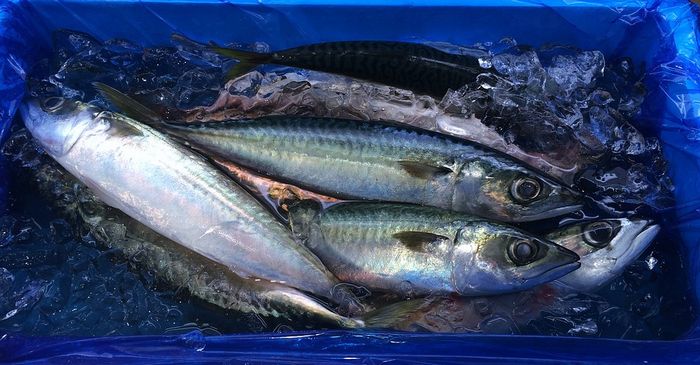
Storage conditions for fruits and vegetables
Store fruits in the refrigerator separately from vegetables. At the same time, apples do not need cold, only darkness. Tomatoes do not like cold temperatures below +8°C. Therefore, it is better to store them in a dark, cool place or on the top shelf of the refrigerator, without any packaging. Cucumbers, cabbage and Bell pepper do not pack tightly, they need ventilation, and do not wash before storage. It is better to wash the greens, dry well and put them in a bag.
Refrigerator temperature The USDA recommends setting the refrigerator temperature to 40 degrees Fahrenheit or lower. food products, especially seafood kept above 40 degrees Fahrenheit for more than two hours should not be consumed. If you are in an angler and plan to eat what you catch, place your fish in a plastic cooler in in large numbers ice. leave drainer cooler open to let water out of the fridge when the ice melts. Close the drain hole only when transporting your catch. With enough ice, properly chilled fish will keep you cool until you get home. Market Chilling When shopping for seafood, look for fish that are properly chilled at the fish market or grocery store. As a rule, this means that the market stores the fish either directly in the refrigeration unit or on ice in a display case. Also, ask yourself if the institution is a practice safe methods food processing, and if it looks and smells clean. good and bad fish Fish should have a faint and fresh smell. The eyes of fresh fish should look clear and bulge slightly. Look for firm and shiny flesh that springs back when pressed. The whole fish must be free from the mucous membrane of the body and have pronounced yellow colors. If your fish smells sour, fishy, or has an ammonia odor, or if the color of the flesh is dull, the fish may be old and should be discarded. Defrosting frozen fish To thaw frozen fish, place it in the refrigerator overnight. This will allow the fish to thaw gradually and prevent spoilage. As alternative method To thaw fish, place it in an airtight plastic bag and submerge it in cold water until thawed. When completely defrosted, keep the fish in the refrigerator for no more than two days before eating. Refrigeration field. . Method of preparation and storage of fish.
If you do not have a cellar, a garage, a cold pantry, then potatoes and beets are stored only in the refrigerator, especially in winter when the heating is on. For carrots, garlic and onions, you can find a cabinet away from heat sources and put them in drawers or baskets.
Shelf life of products without labels
A product bought in a supermarket must contain full information on the conditions and terms of storage on the label. And how long to store fish, meat, milk bought at the market? How long can you eat prepared meals?
Because of its abundance, proven health benefits, and protein concentration, fish makes an excellent main course choice. Fish contains omega-3 fatty acid, which have been proven to reduce the risk of heart disease and help with many other health problems.
Of course, fish last for a shorter period of time if not stored properly. But remember that fish, like many others, usually sells by date, not by expiration date. Because of this difference, you can safely use the fish even after the sale by date has ended. If fresh fish has a purchase date, then it is recommended to either cook or freeze the fish by that date.
Meat shelf life
Chilled lumpy meat is stored up to 72 hours (temperature 0 +8°C). At the same time, meat on the bone - up to 48 hours, as well as small pieces. Minced meat - no more than a day, but if onions and spices are already added to it - no more than 12 hours.
Chicken carcass or parts, in the refrigerator - up to 48 hours. Minced chicken - up to 12 hours, minced fillet - up to 24 hours. All by-products (slaughter animals and birds) - 24 hours.
Freezing meat significantly increases the shelf life. If the temperature in the freezer is below -18°C - up to 9-12 months. Of course, you should not resort to such long storage, because the taste is very affected. If you freeze the meat, and then put it in the refrigerator, then you can store it for up to 5 days.

Fish at a temperature of 0 to +8°C is stored for up to 48 hours. Minced fish, cutlets - no more than 12 hours. In deep freezing, it is stored for up to 10 months, but it is better to avoid this, as the taste of the fish changes dramatically.
Shelf life of prepared meals
The optimal shelf life of ready meals at home is 72 hours. If you are confident in the quality of the raw materials, it can be longer, but the food must be tightly closed, for example, in plastic containers, and do not forget to warm it up well when serving. Heat only the amount that will be eaten.
Shelf life of salads
Any salads with fresh vegetables and herbs, such as arugula or lettuce, are not subject to storage. They can be prepared in a couple of hours, and seasoned right before serving.
Salads from boiled vegetables and meat, seasoned with oil or mayonnaise (vinaigrette, olivier), according to regulatory documents governing the storage time finished products in public catering, only 6-12 hours are good. At home with proper storage period can be extended up to 48 hours.
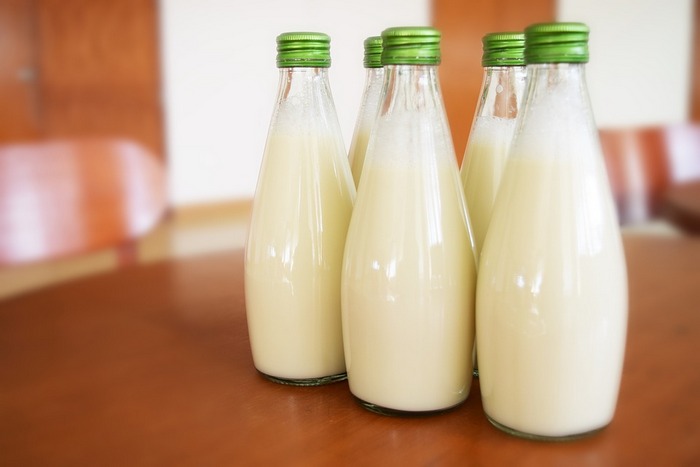
Shelf life of dairy products
Fresh milk is stored in the refrigerator for up to three days, boiled - up to five. Kefir, curdled milk, fermented baked milk - 3-5 days. Sour cream - 4-5 days. Cottage cheese - 3-4 days. Cheeses - up to 10 days in the refrigerator, up to two months in the freezer.
How long can desserts be stored
Homemade cakes and pastries at a temperature of +4 - +6 ° C with cream:
- from protein - 96 hours;
- creamy - 72 hours;
- custard or cottage cheese - 36 hours;
- sour cream - depending on the type of sour cream: you can increase the shelf life up to 72 hours using pasteurized sour cream with a long shelf life.
We eradicate the love of shopping for future use
Most modern housewives spend most of the day at work, so they try not to leave the refrigerator empty: “What if I stay late at work and my children or my husband get hungry?” So in our free time, we go to the store and buy food for the future, and then each revision of the refrigerator ends with the discarding of spoiled goods. It is impractical from the point of view of economy, firstly, and secondly, a child who does not know about the expired expiration date, for example, of yogurt, can eat it. IN best case the child will get an intestinal disorder, at worst - poisoning.
Make up in your spare time sample menu a week ahead, write down a list of necessary products, go to the supermarket or the market. If you consider it necessary to buy additional "sweets" - take one or two units. Does your child have a milk dessert as a snack, but want something different the next day? Do not then take a package of four pieces.
Worth buying:
- canned food that does not require storage low temperatures;
- cereals, but do not forget that insects can start in them, so it is better to store them in jars with a tight-fitting lid;
- frozen semi-finished products: if they are made from natural ingredients, then their shelf life at temperatures below -18 ° C is usually about 60 days, if preservatives are added - up to 9 months, so read the labels carefully;
- fresh chilled meat, if frozen immediately, will keep in the freezer for up to 12 months.
Even if the product long term storage, it is better to buy one that has a closer production date: such a product has undergone fewer violations of storage conditions during transportation and display on the shelf.
Any product can be stored longer only if it is indicated on the packaging. Read it carefully - do not forget that we are talking about the health of you and your loved ones.
Storage of prepared meals. Many ready-made dishes (broths and first courses in meat, fish or mushroom broth, second courses of meat, poultry, fish, stewed vegetables, mushroom dishes, cold dishes - jelly, jellied meat and fish, vinaigrettes, salads, as well as confectionery with cream) refer to perishable products. Meat, fish, mushroom, strong broths, frozen decoctions of jellied dishes, dressed with butter, sour cream or mayonnaise vinaigrettes and salads, creams are a good breeding ground for microorganisms that multiply very quickly in them. After 4-6 hours of storage of these dishes at room temperature it is dangerous to eat them. Therefore, the listed dishes are kept in the refrigerator at a temperature of + 4-6 ° for no more than 72 hours. with each boiling and heating, vitamins are partially destroyed. Jellied dishes and jellies are stored in the refrigerator for no more than 12 hours, cakes and cakes (cooked at home or purchased in a store) with protein-whipped cream or fruit finish - no more than 72 hours, with butter cream - 36 hours, with custard- 6 hours in storage prepared food it is necessary to strictly observe sanitary and hygienic requirements: keep the place of storage, utensils and packaging clean, prevent the contact of ready-made meals and products eaten without additional processing (sausages, cheese, cottage cheese, etc.), with raw products and semi-finished products, as well as with contaminated products (vegetables, etc.).
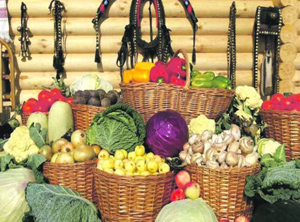
Storage of meat, fish, meat and fish products. Of the meat and fish products, semi-finished products (with the exception of dumplings, which can be frozen) and offal spoil most quickly. When frozen, the taste qualities of semi-finished products and by-products deteriorate significantly. Recommended shelf life of semi-finished products and offal in the refrigerator: portioned semi-finished meat products(beef steak, entrecote, langet, etc.) - 36 hours, breaded (schnitzel, rump steak, etc.) and small-sized (beef stroganoff, goulash, stew, etc.) semi-finished meat products - 18-24 hours, cutlets , chopped steaks, liver, kidneys, brains, etc. - 12 hours, chopped meat, cabbage rolls, peppers, zucchini stuffed with meat and rice - 6 hours; semi-finished products from poultry: natural fillet - 48 hours, breaded fillet - 24 hours, chopped cutlets, offal - no more than 12 hours. Fish semi-finished products, breaded in breadcrumbs, store no more than 24 hours, fish cakes - 12 hours.
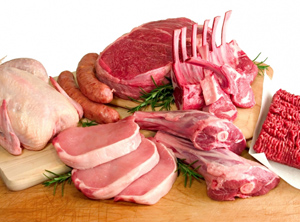
Meat, fish, poultry in its natural form should not be kept at room temperature. In a refrigerator at a temperature of 0 to + 8 °, fresh and chilled meat and poultry are stored for up to 72 hours, fish - 48 hours, frozen meat and poultry - up to 5 days, frozen fish - 3 days. By placing frozen meat, fish or poultry in the freezer, you can significantly extend their shelf life. In case of defrosting, regardless of subsequent storage conditions, meat, fish and poultry must be sold within 24 hours.

The shelf life of sausages, sausages, hams and smoked meats depends. from the way they are made. Boiled, stuffed, liver sausages, black puddings, sausages, sausages, boiled hams, boiled pork, etc. at home, they are stored only in the refrigerator at a temperature of 0 to + 8 °. At the same time, boiled sausages premium, boiled ham, boiled pork, a piece of roll (not cut) can be there for 72 hours, boiled sausages of the 1st, 2nd and 3rd grades, sausages, sausages, liver sausages of the highest and 1st grade, top-grade brawns - 48 hours, boiled sausages of the 3rd grade, brawns of the 1st and 2nd grades, black pudding of the 1st and 2nd grades, liver sausages of the 2nd grade - 24 hours, liver sausages, blood brawns of the 3rd grade and jellies - no more than 12 hours. Semi-smoked and boiled-smoked sausages are stored at room temperature (not higher than 20 °) for up to 3 days, in the refrigerator at a temperature of 0 to + 8 ° - 10 days. The same period is valid for smoked meats (smoked rolls, ham, brisket, etc.). Raw smoked sausages placed in a cool dry place can be stored indefinitely. When mold appears on the casing of a loaf of sausage, it is wiped with a clean cloth, abundantly moistened with a 20% solution table salt or 3% acetic acid solution, and then dried. When removing mold, you should try not to damage the shell of the loaf. After removing the mold, the sausage can no longer be stored. Sometimes when long-term storage on the surface of raw smoked sausage, a white dry coating of table salt appears. Plaque does not reduce the taste of the product, it can not even be removed.

Salting, pickling and smoking increase the shelf life of fish products. Lightly salted fish (6-10% salt) can be kept in the refrigerator for up to 6-7 days, medium and strong salted fish - longer. Hot-smoked fish is stored in the refrigerator for up to 3 days, cold-smoked fish - 8-10 days, dried fish - in a cool, dry place, periodically examining it. Moldy carcasses should not be eaten. Salt deposits do not affect the quality of dried fish.

Storage of milk, dairy products and eggs. All dairy products are best stored in the refrigerator. Fresh milk in any container - no more than 36 hours, boiled milk - up to 3 days, lactic acid products (kefir, yogurt, acidophilus) - 24-36 hours, sour cream - up to 3 days, cottage cheese and cheese curds - 36 hours, sweet cream cheeses in polymer packaging - up to 48 hours. Butter in the refrigerator at temperatures above 0 ° is stored for up to 10 days, in the freezer - more long time, cheeses - up to 15 days, chicken eggs - up to 20 days.
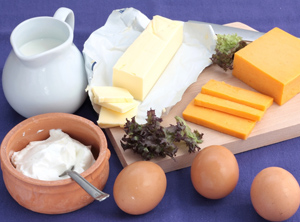
Storage of vegetables, fruits and berries. At home, at room temperature, ripe vegetables, fruits and berries deteriorate relatively quickly. Usually, after 12-24 hours, berries begin to turn sour, especially strawberries, strawberries and raspberries; tomatoes and food greens quickly rot. Ripe apples, pears, oranges at room temperature and without damage are stored for 2-3 days. Washed vegetables and fruits rot in 6-12 hours. Root crops (potatoes, beets, carrots) can be kept at room temperature in a dry place for up to 10-14 days. But beets and carrots can dry out, losing their taste and vitamin value. In a warm room, potato tubers can sprout, which is accompanied by an increase in the content of the toxic substance solanine in them, which can cause severe poisoning. Mature watermelons, melons, pumpkins are stored at room temperature for 10 or more days if their peel does not have abrasions and damage; melons spoil faster. Onion and garlic in a dark dry place at room temperature can be kept for 1 month. and more.
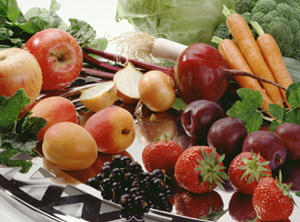
Long-term storage of vegetables and fruits in urban conditions can be in the refrigerator. To do this, select vegetables and fruits good quality, without damage to the surface, sluggish, frost-free. They should be clean (but not washed) and kept in a container with a lid or in a plastic bag. The shelf life in the refrigerator for most vegetables and fruits has not been established, but they should be checked regularly: if there are areas of softening, spots on the peel and other early signs damage to store them longer is not recommended. It is also not recommended to keep berries and food greens in the refrigerator for more than 24-48 hours.
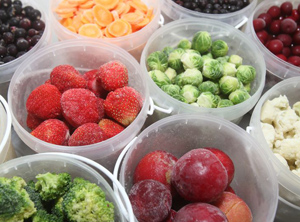
After harvesting for personal plot fresh vegetables placed in a cellar or underground. In order for vegetables to be preserved during the winter, the temperature in warehouses must be between 0 and + 2°. At 5°, some vegetables begin to sprout and deteriorate. Especially it is necessary to monitor the potatoes: they must be kept in a cool dark room, without access to sunlight.
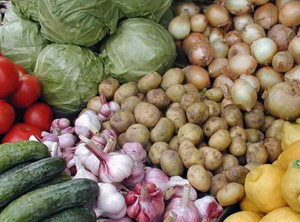
Fruits (apples, pears, etc.) it is better to store separately from vegetables, because. they quickly absorb odors and change the taste. Best conditions for fruits: temperature from + 2 to 0 °, relative humidity in the range of 85-95%, regular supply of fresh air.
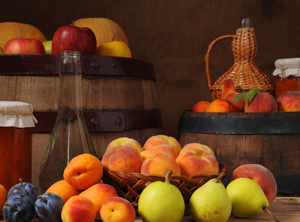
Storage of canned goods. Sterilized factory-made canned food can be stored for a long time at normal temperature. Do not keep canned food at elevated temperatures (in hot rooms, near heaters, etc.). Canned fruit - jams, jams, juices, syrups - darken in a warm room, change color, canned food in unvarnished tins acquire an unpleasant, metallic taste. Storage at low temperatures of canned food with a high sugar content (jam, jams, condensed milk, etc.) leads to their sugaring.
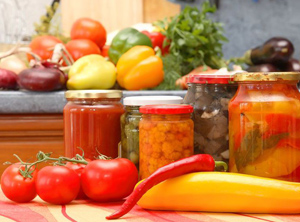
Special attention is required for unsterilized canned food in tin and glass jars- the so-called preserves. They are kept at low temperature, but not below 0°. In hot weather, in the absence of a refrigerator, they should not be stored for more than 2-3 days. The conditions and shelf life of preserves are usually indicated on the label or on the lid of the jar. Once opened, a canned product cannot be stored longer than the same product that has not been preserved. For example, after opening a can, the recommended shelf life of condensed milk in a refrigerator at a temperature of 0 to + 8 ° C should not exceed 72 hours, canned meat - up to 48 hours, etc. Meat, fish and vegetable canned food should be immediately shifted from cans in glass or enamelware.
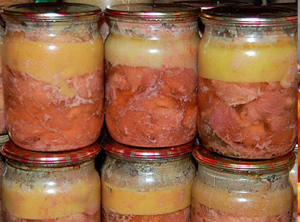
Dry food storage. Dry bulk products are kept in dry, well-ventilated areas. An increase in the amount of moisture in products over 5% contributes to their deterioration. Products are moistened in non-ventilated, basements as well as sudden changes in temperature. You can store dry products in paper bags, linen bags, and also in jars with lids. Dry products easily perceive and retain foreign odors for a long time, which should also be taken into account when storing them.
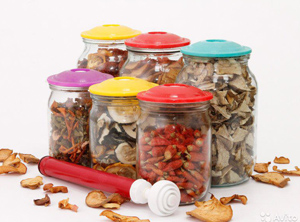
Storage of bread and bakery products. It is best to use special bread bins or enamelware with a lid. rye and wheat bread stored separately. Bread in plastic bags dries less, but at the same time extraneous odors appear, it is moistened. So keep bread and bakery products in plastic bags only recommended for a short time

Real advice! Find out first!





